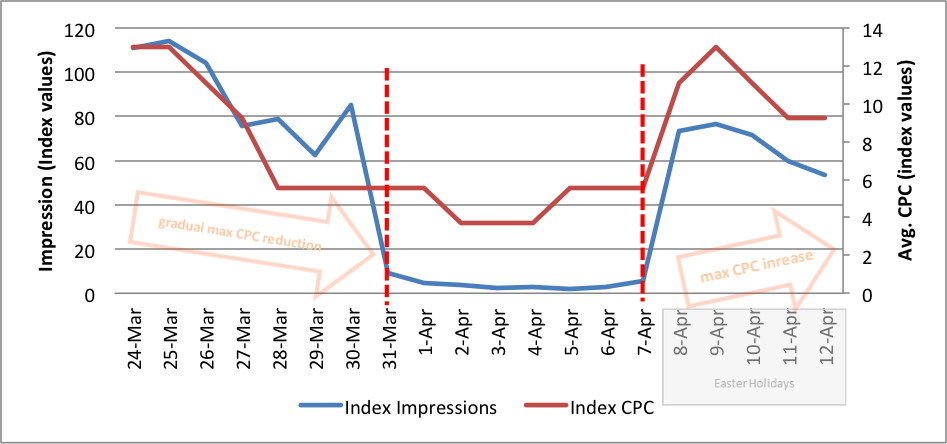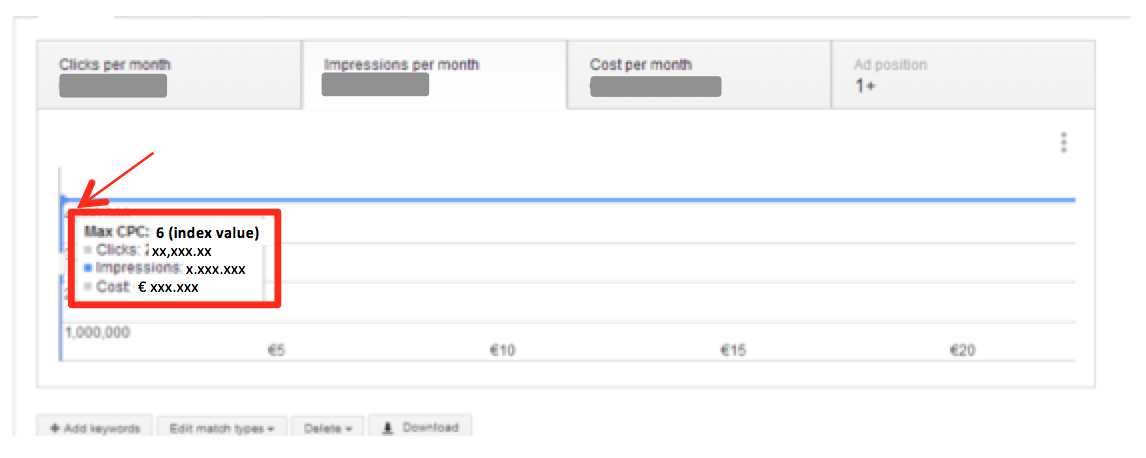Impression share metrics are often used as the key indicator of one’s market share. A 100% impression share would indicate that you are reaching the entire traffic volume. But this metric would be misleading.
Our case study reveals that total impression share can be a quite misleading metric for determining your share of total voice. The metric is a better indication of your share in auctions. Moreover, we show that your bid influences the number of auctions you participate in.
The Case Study – And How We Were Fooled By The Impression Share Metric
A keyword’s ad rank is determined by multiplying quality score and the max CPC:
- Ad rank = Max CPC x Quality Score
Therefore, the keyword with the highest bid and quality score is ranked highest. Based on this model, we proposed the following hypothesis:
If we are the only bidders on a certain keyword and have a constant quality score of 10, we can set our max CPC to a minimum and are still ranked on position 1. Thereby we can reduce our price per click and our costs.
As a secondary condition, we assumed that our market share remains constant. Thus, we gradually lowered the max CPC for an exact keyword which has the following attributes:
- High impression volume
- Low competition
- Average position 1
- 98.01% total impression share (1.99% were lost due to rank)
- Constant quality score of 10
- Not targeting mobile devices
- Google Search only
- No budget restrictions
An astonishing thing happened. As expected, the CPC decreased by 40% compared to the previous period, but the total numbers of impressions dropped dramatically (-95.46%). The following graph shows the number of impressions dropped significantly on March 31st.
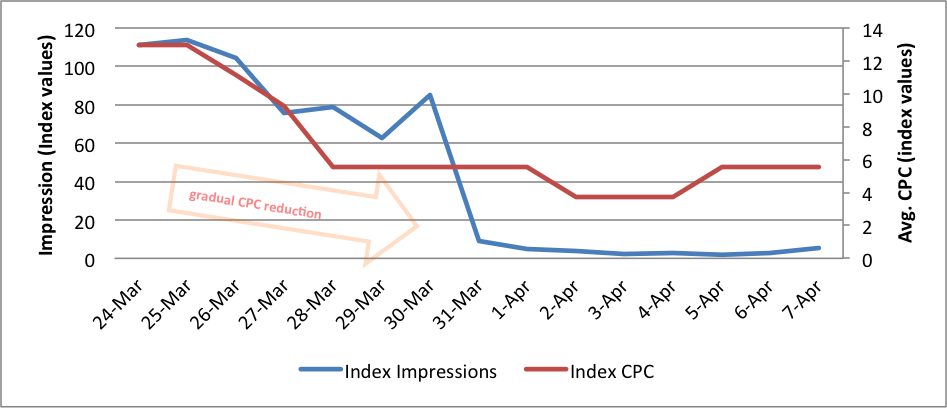
But looking at the impression share, we still nearly reached the entire audience (impression share 97.96%). Additionally, we continued to be ranked at position 1 and the competitive situation stayed constant.
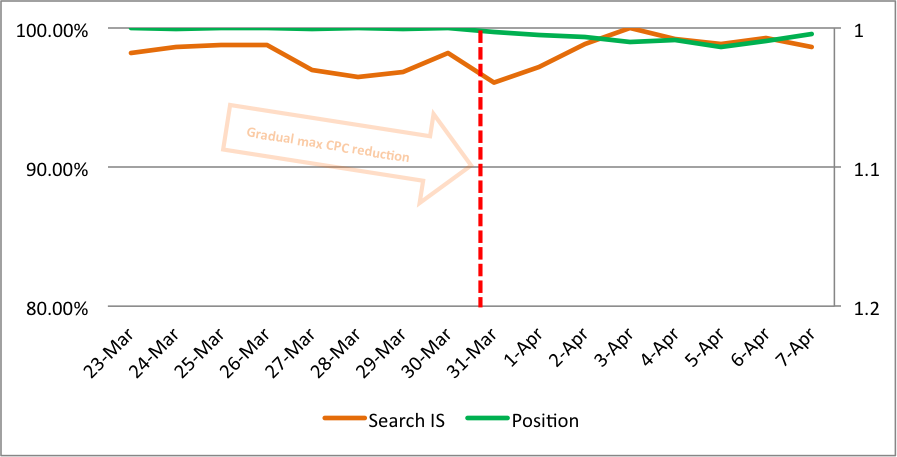
We first concluded that the total market volume declined. Let’s do a small calculation to see what that would mean:
- Total market volume = (Impressions / Search Impression Share) x 100 %
So the total market volume dropped by 95.44% within one week? That seems inaccurate. Thus, we assumed that the impression share and the CPC must be dependent, so increasing the CPC would recover our impression volume. And that’s what happened: our total impression volume nearly recovered (there is still a seasonal decline due to Easter holidays):
In the end, the total impression metric was not reliable and seemed to be dependent on the CPC.
But How Big Is My Piece Of The Pie? Can I Determine The Market Volume?
To see how the traffic volume really developed we looked up the keyword in Google Trends.
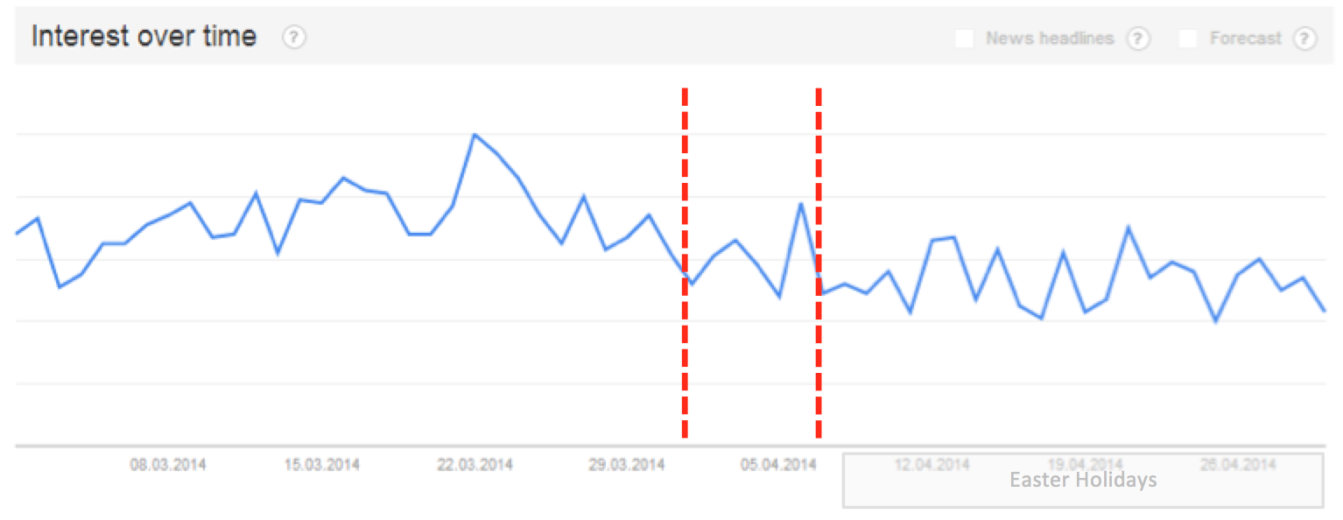
The data proves our latest assumption: the total market volume did not diminish that harshly. The decline in search volume can be explained by Easter holidays in Germany. Unfortunately, Google Trends only provides index values but not total numbers.
Another slightly better tool is the Adwords Keyword Planner. Since the latest update, it provides retrospective search volume data and some real numbers.
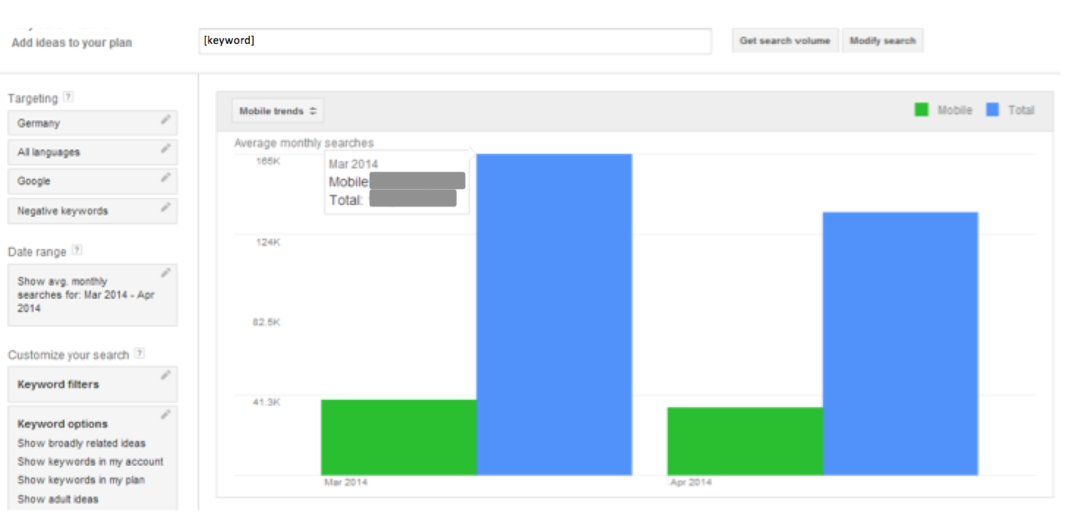
So let’s compare the keyword planner data to our monthly data. We assumed that the values in the keyword planer are displaying the whole market volume. Note, that we have excluded the mobile search volume. The search volume share is calculated the following way:
- Search Volume Share = Impressions / (Total Search Volume – Mobile Search Volume) x 100 %
Our search volume share in March was 86.80% and 66.10% in April. That differs greatly from the impression share metric in the campaign interface, which was 97.81% in March and 97.43% in April. So we lost market share in April.
Although this tool provides better estimates for your market share, it has some heavy drawbacks:
- Figures are rounded up
- Data is accumulated across all devices
- Data is only available for last 12 months
- Broad and exact match keywords search volume is the same
It is difficult to determine the real search volume with Google tools, but at least you can get a rough estimate.
What The Impression Share Metric Might Really Tell You – Be Aware Of The Minimum CPC
You might wonder how the discrepancy between the total search volume and our total number of impressions can be explained and what the impression share metric is really about.
It is quite possible that not every search request leads to an ad auction. For example, people use ad blockers or the Google algorithm classifies keywords irrelevant for a certain user history. That’s why your impressions mostly differ from the total search volume, even if you have 100% impression share.
But there might be two other explanations:
- A simple assumption seems to be quite reasonable: Google utilizes a quite uncommon pricing model. You have to pay an additional charge for a higher volume of traffic instead of getting volume discount. Consequently, the impression share would be directly related to your max CPC.
- The more plausible explanation states that a minimum CPC is required to enter the auction. Google confirmed that some years ago (read here). The minimum CPC is automatically determined by the Google algorithm. At least 0.01€ is required, but it is higher the lower your quality score is. Furthermore, you have to consider that the real quality score range differs from the quality score in the interface. Even a quality score of 10 in the interface does not mean that you have the highest possible quality score in the Google system. Moreover, the quality score fluctuates from auction to auction. Assuming that our quality score is not the highest value possible and our minimum CPC is not 1 cent. By reducing our bid it was more likely that we underbid this minimum CPC in more auctions than before.
To undermine the last hypothesis we used the bid estimator within the keyword planner keyword. The following graph illustrates that a minimum bid is required (in this case more than one cent) for the respective keyword. Above this threshold the number of impressions stays constant. Moreover, it shows that the potential audience is around 4,100,000 per month if you bid more than the minimum CPC.
Finally, we conclude that the impression share refers to the number of auctions in which you have competed, not your share of the whole market volume. There is no direct relationship between market share and CPC, but between the numbers of auctions you participated. But the number of auction is indirectly related to your bid. The number of auctions in which you are competing, depends on you overcoming the minimum CPC requirement.
What Can PPC Hero Readers Learn From Our Case Study
- Be careful when using the impression share. It only tells you the share of auctions you competed but not your share in the market.
- If your number of impressions drops and you cannot explain it by seasonal effects, remember the minimum CPC hypothesis: You need to overbid the minimum PPC to enter the auction.
- There might be different reasons why you are below the minimum CPC
- Last but not least the keyword planer tool might help you to find the minimum CPC and give you a rough estimate of the total market share.
- Always be sure that you bid at least the minimum CPC.
The case study leads to further questions: Are there ways to detect your real market share? How can I calculate my minimum CPC? If you have ideas I would be happy to discuss!



